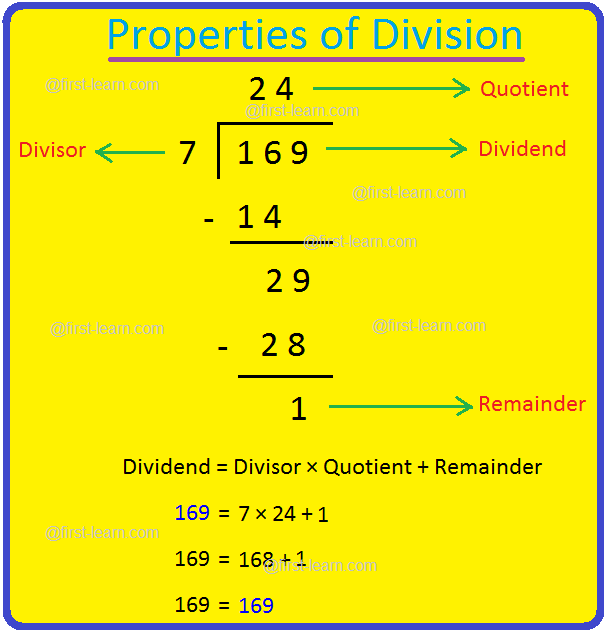Properties of Division
There are few properties of division like other basic operations (such as addition, subtraction and multiplication) which are helpful in better understanding of the concept and ideas. These properties will help the learners in easier understanding and even for the purpose of self checking the division problems done. Each of the properties is narrated below:
1. If any whole number (other than zero) is divided by itself then the answer or the quotient is one.
For Example:
(i) 5 ÷ 5 = 1
Again, as we know that division is an inverse of multiplication hence 5 = 5 × 1
(ii) 25 ÷ 25 = 1
Again, as we know that division is an inverse of multiplication hence 25 = 25 × 1
2. If any whole number (other than zero) is divided by 0 then it is undefined or meaningless
For Example:
(i) 47 ÷ 0 = undefined
(ii) 5 ÷ 0 = undefined
(iii) 225 ÷ 0 = undefined
3. If zero divided by a non- zero whole number, the answer is zero.
For Example:
(i) 0 ÷ 5 = 0
(ii) 0 ÷ 10 = 0
(iii) 0 ÷ 50 = 0
4. If any non zero whole number is divide by 1, then the quotient will be the whole number itself.
For Example:
(i) 5 ÷ 1 = 5
(ii) 23 ÷ 1 = 23
(iii) 15 ÷ 1 = 15
5. If any whole number (other than zero) is divided by another non-zero whole number, the quotient is not necessarily a whole number.
For Example:
(i) 25 ÷ 2 = 12.5
(ii) 10 ÷ 3 = 3.333
(iii) 27 ÷ 4 = 6.75
So, in these cases we can see that a whole number is divided by another whole number and the result is not a whole number. The answer is in decimal.
6. If there are three whole number out of the three one is dividend, another divisor and other is quotient. Now if the divisor and the dividend is not zero then divisor multiplied by quotient is dividend.
For Example:
(i) 25 ÷ 5 = 3
Here, 25 is the dividend, 5 is the divisor and 3 is the quotient.
Now according to the property divisor multiplied by quotient is the dividend
So, 5 × 3 = 15
(ii) 50 ÷ 10 = 5
Here, 50 is the dividend, 10 is the divisor and 5 is the quotient.
Now according to the property divisor multiplied by quotient is the dividend
So, 5 × 10 = 50
iii) 39 ÷ 13 = 3
Here, 39 is the dividend, 13 is the divisor and 3 is the quotient.
Division Equation: Dividend = Divisor × Quotient + Remainder
Now according to the property divisor multiplied by quotient is the dividend
So, 13 × 3 = 39
169 ÷ 7
Dividend = Divisor × Quotient + Remainder
= 7 × 24 + 1
= 168 + 1
= 169
7. If there are three whole numbers (other than zero) p, q and r. If q × r = p, then p ÷ r = q and p ÷ q =r
For Example:
(i) 8 × 6 =48
Then, 48 ÷ 6 = 8 and
48 ÷ 8 = 6
(ii) 9 × 5 = 45
Then, 45 ÷ 5 =9 and
45 ÷ 9 = 5
From Properties of Division to HOME PAGE
Recent Articles
-
Explain about Growth in Plants |Definition of Growth & Differentiation
Feb 27, 25 02:07 PM
Growth is a permanent increase in length or volume of an organism that brought upon by an increase in its dimensions due to synthesis of new protoplasmic material. -
Definition of Respiratory Quotient | calculation | Application | Plant
Dec 02, 24 12:09 AM
Definition of respiration quotient- the ratio of the carbon-dioxide evolved to that of the oxygen consumed by a cell, tissue, plants or animals in a given time is called respiratory quotient. It is us… -
Amphibolic Pathway | Definition | Examples | Pentose Phosphate Pathway
Jun 06, 24 10:40 AM
Definition of amphibolic pathway- Amphibolic pathway is a biochemical pathway where anabolism and catabolism are both combined together. Examples of amphibolic pathway- there are different biochemical… -
Respiratory Balance Sheet | TCA Cycle | ATP Consumption Process
Feb 18, 24 01:56 PM
The major component that produced during the photosynthesis is Glucose which is further metabolised by the different metabolic pathways like glycolysis, Krebs cycle, TCA cycle and produces energy whic… -
Electron Transport System and Oxidative Phosphorylation | ETC |Diagram
Feb 04, 24 01:57 PM
It is also called ETC. Electron transfer means the process where one electron relocates from one atom to the other atom. Definition of electron transport chain - The biological process where a chains…





New! Comments
Have your say about what you just read! Leave me a comment in the box below.